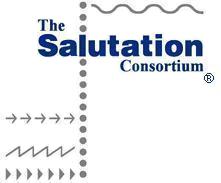
- What is the difference between Salutation and JetSend?
These two technologies are very similar in their visions of heterogeneous interoperability, but
have approached the solution from different point of view. Salutation supports a process to
determine the characteristics of a device, application or service, with the process adjusting
interactions based on discovered Functional Unit Capabilities. JetSend supports a process to tell a
device, application, or service what formats and protocols the process supports, allowing the
device, application, or service to select which to use. JetSend is a content negotiation protocol.
It allows two devices or information appliances to negotiate the best way to exchange
information.
- Which technique is better?
Each of these approaches has a place in building communications between interconnected devices, applications, and services.
- Where is Salutation best utilized?
Salutation provides benefits in a directory centric environment, as it provides detailed information
about interconnected entities that can be maintained in a directory service. In fact,
implementations of the Salutation Manager contain a scalable directory. Salutation information
SUPPORTS a process to determine and fully utilize unique features of a connected device,
application or service.
- Where is JetSend best utilized?
JetSend provides benefits in ad hoc communications between devices where a directory-centric
model does not apply. In the content negotiation process, JetSend allows a sending device to tell
a receiving device what data types, formats and capabilities it supports. The receiving device can
then make an intelligent selection to produce the highest quality information exchange between
the two devices.
- If these two technologies support different approaches to interoperability, why are HP and Salutation studying integrating the technologies?
Salutation and HP are both focused on meeting users needs. Users may be faced with
environments where both technologies are equally valid. These use s are best served if these
technologies supplement and complement each other. Rather than faced with a choice between
two different implementation, integrating these two technologies will provide users with the best
of both approaches.
- Why wasn't this integration performed prior to the JetSend announcement?
HP has been a member of the Salutation Consortium since its inception, and has been
investigating approaches of supporting JetSend in the Salutation Architecture. HP is working
with other Salutation Consortium members to identify areas where integration makes sense. The
first checkpoint is the Salutation Consortium's Technical Committee meeting to be held in
October, 1997.
- What will integration entail?
There are several approaches under consideration. One example is the creation of a JetSend
Functional Unit in the Salutation Architecture. The JetSend Functional Unit would provide a
mechanism for describing the format and protocol choices provided by the JetSend process. Such
a mechanism would potentially allow a user to utilize the Salutation APIs and protocols to
determine the 'JetSend capabilities' of a remote device application or service, with the response
indicating the remote entity's choice.
- The HP JetSend White Paper available at (http://www.jetsend.hp.com) discusses applicability to
a broad range of information appliances including those found in the home. Does this present
difficulty for Salutation?
No, Salutation has been working with home network industry initiatives, and has produced a white paper focused on using Salutation in the home. This white paper can be viewed on the World Wide Web at http://www.salutation.org/ussalute/salinhome2.htm.